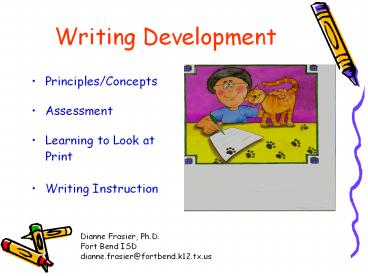Writing Development - PowerPoint PPT Presentation
Title:
Writing Development
Description:
Principles/Concepts Assessment Learning to Look at Print Writing Instruction Dianne Frasier, Ph.D. Fort Bend ISD dianne.frasier_at_fortbend.k12.tx.us Writing Development – PowerPoint PPT presentation
Number of Views:144
Avg rating:3.0/5.0
Title: Writing Development
1
Writing Development
- Principles/Concepts
- Assessment
- Learning to Look at
- Writing Instruction
Dianne Frasier, Ph.D. Fort Bend
ISD dianne.frasier_at_fortbend.k12.tx.us
2
Early Writing Theory
- Organizes the visual analysis of print
- Directionality
- Objective evidence of what child has learned
- Close connection to early reading
Clay, M.M. 1975. What Did I Write? Beginning
Writing Behavior, Heinemann.
3
Recurring Principle
Clay, M.M. 1975. What Did I Write? Beginning
Writing Behavior, Heinemann.
4
Clay, M.M. 1975. What Did I Write? Beginning
Writing Behavior, Heinemann.
5
Directional Principle
Clay, M.M. 1975. What Did I Write? Beginning
Writing Behavior, Heinemann.
6
Generating Principle
Clay, M.M. 1975. What Did I Write? Beginning
Writing Behavior, Heinemann.
7
Inventory Principle
Clay, M.M. 1975. What Did I Write? Beginning
Writing Behavior, Heinemann.
8
Contrastive Principle
Clay, M.M. 1975. What Did I Write? Beginning
Writing Behavior, Heinemann.
9
Flexibility Principle
Clay, M.M. 1975. What Did I Write? Beginning
Writing Behavior, Heinemann.
10
Sign Concept
Clay, M.M. 1975. What Did I Write? Beginning
Writing Behavior, Heinemann.
11
Message Concept
Clay, M.M. 1975. What Did I Write? Beginning
Writing Behavior, Heinemann.
12
Rating RubricLanguage Level
- Alphabetic (letters only)
- Word (any recognizable word)
- Word Group (any two word phrase)
- Sentence (any simple sentence)
- Punctuated Story (of two or more sentences
- Paragraphed story (two themes)
Clay, M.M. 1975. What Did I Write? Beginning
Writing Behavior, Heinemann.
13
Rating RubricMessage Quality
- Has a concept of signs (uses letters, invents
letters, uses punctuation - Has a concept that a message is conveyed (tells
you a message but what is written is not that
message) - A message is copied and knows more or less what
message says - Repetitive, independent use of sentence patterns
like here is a - Attempts to record own ideas, mostly
independently - Successful composition
Clay, M.M. 1975. What Did I Write? Beginning
Writing Behavior, Heinemann.
14
Rating RubricDirectional Principles
- No evidence of directional knowledge
- Part of the directional pattern is known start
top left, move left to right, return down left - Reversal of the directional pattern (right to
left and/or return down right). A sample with
one lapse should be rated at this level. - Correct directional pattern
- Correct directional pattern and spaces between
words - Extensive text without any difficulties of
arrangement and spacing of text
Clay, M.M. 1975. What Did I Write? Beginning
Writing Behavior, Heinemann.
15
Rubric
A B C
Language Level Message Quality Directional Principles
Not yet Satisfactory 1-4 1-4 1-4
Probably Satisfactory 5-6 5-6 5-6
16
Writing Samples
17
Visual Discrimination
- The visual discrimi-nation of each symbol, one
from another, is a large learning task and the
accumulation of skill is slow and gradual over
the first two years of instruction for children
who begin school at five years. Clay, B. L., p.
267
18
Learning to Look at Print
19
Looking at Print
- E m 3
- U n h r
20
Often the first two or three letters that
occur in a childs name become distinctive
because of these efforts. (learning to write
his/her name). Clay, B. L., p. 267
21
(No Transcript)
22
(No Transcript)
23
- Children find it easiest to distinguish letters
with the maximum of contrast at first. This is a
good teaching principle they must gradually
learn the minimal differences for discrimination
within sets of similar letters. - Clay, B. L. p. 281
24
Journal Writing
Demonstrated Writing
Shared Writing
Instructional Terms
Guided Writing
Interactive Writing
Writers Workshop
Independent Writing
25
InteractiveWriting
26
During VideoThink About
- Teachers role
- Decision making
- Teachers language
- Students role
- Active
- Construction of Text
27
In the end, I suspect that excellent teachers
will do what they have always done grow. And
the growing will be as it has ever been the
result of their tuning in to their
students, responding to them, and learning
from and with them even as they teach
them. Lindfors, 1987, p. 386
28
Baghdan, M. (1984). Our Daughter Learns to Read
and Write. International Reading
Association. Clay, M. (1975). What Did I
Write? Beginning Writing Behavior. Heinemann. C
lay, M. (1991). Becoming Literate The
Construction of Inner Control.
Heinemann. Ferreiro, E. Terberosky, A.
(1982). Literacy Before Schooling. Heinemann. S
chickedanz, J. A. (1999). Much More than the
ABCs The Early Stages of Reading and Writing.
National Association for the Education of Young
Children. Teale, W.H. and Sulzby, E. (Eds.)
(1986). Emergent Literacy Writing and
Reading. Ablex.































